5. Words Worth
Remembering
 The early Christians in Antioch, we can be sure, were eager to
know as much about Christ as possible. Paul and Barnabas, we are told,
instructed them for a full year. For a whole year they met with the community
and taught many people (1). This was around 39 AD, hardly ten years after
Jesus' death and resurrection. Since the Gospels of Matthew, Mark, Luke and
John had not yet been written, how did Christian teachers pass on what Jesus
had said and done? The early Christians in Antioch, we can be sure, were eager to
know as much about Christ as possible. Paul and Barnabas, we are told,
instructed them for a full year. For a whole year they met with the community
and taught many people (1). This was around 39 AD, hardly ten years after
Jesus' death and resurrection. Since the Gospels of Matthew, Mark, Luke and
John had not yet been written, how did Christian teachers pass on what Jesus
had said and done?
Before we turn to the New Testament itself for enlightenment, we
must have another look at Antioch and see what educational methods were in
vogue there at the time.
The school of life
We take it for granted that most people learn to read and write.
In the Greco-Roman Empire just a few people were literate. The vast majority of
people would pick up basic information about society and the world from what
their parents told them, from guild masters who imparted a skill, from hearing
stories and gossip in their day-to-day contacts and from attending public
meetings and cultural events.
A truly literary education was reserved to the children of
upper-class families. From the age of seven to fourteen, a son (more rarely a
daughter) was entrusted to the pedagogue, the teaching slave. The child learned
the alphabet, read anthologies of famous texts and was taught how to cope with
numbers and fractions. History and geography were imparted in the form of
stories. At the age of fourteen, the son would join the gymnasium where he was
introduced to Greek culture. This involved sport (wrestling and discus
throwing), playing an instrument (the flute or the zither), savouring Greek
literature from Homer to Menander, mathematics, astronomy and, especially,
rhetoric: the art of public speaking. Whoever had been privileged enough to
receive this education was well prepared to take on a position of leadership,
say as a magistrate or city councillor. (2) One of the senior members of the
Church at Antioch, Manaen, belonged to this group. He ‘had been educated
with Herod the Tetrarch’. (3)
People in the upper middle classes, physicians, architects, ship
builders, merchants and the like, also learned to read and write, but only for
practical purposes. They needed to conduct correspondence, decipher or sign
legal documents, study professional literature regarding their trade. They
picked up their knowledge from personal tutors and would normally rely on a
trained clerk to write out letters or read texts aloud. Paul belonged to this
class. As the son of a prosperous tent-maker of Tarsus, he had learned the
Greek script. But he never quoted from Greek literature (4) and usually
dictated his letters to more skilled companions.(5) Only towards the end of the
letter would he add a few personal lines with his own hand,(6) and his writing
appears to have been somewhat clumsy. (7)
Paul, who had been educated as a Pharisee and had spent some years
in Jerusalem as a disciple of Gamaliel,(8) also knew how to read and write in
Hebrew, the language of the Old Testament. But in the rabbinical school he had
learned the interpretation of the Law through oral instruction. Opinions of
famous rabbis were committed to memory according to rigorous patterns; then
explained. (9) These concerned 'the traditions of the elders' which were
contained in the mishnah.(10)
It is difficult for us to imagine the place which memorisation
held in the transmission of rabbinical religion. Here are some of the
features.(11)
Great care and attention was given to preserving the exact
wording of the teachings of an ancient master. A careful study was made
regarding the authenticity of the tradition. The words of the master, tersely
expressed, were not synopsised. They were quoted as the master had said them -
together with the name of the one who had uttered them. An ancient rule for the
pupils was this: It is a man's duty to state a tradition in his teacher's
words.
While the pupil was thus in duty bound to preserve his teacher's
exact words, the teacher was responsible for drilling his pupil in their
memorisation. A teacher could not simply mention the oral material (his own
doctrinal statements or teachings handed down to him) in a general fashion. He
must repeat it over and over again, and make his pupils repeat it, until they
know it by heart. The rule was: A teacher's duty is to repeat a passage to
his pupil until he has learnt it.
Although some written notes may have existed, it was not these
but the oral traditions that were normative. The rule was: You shall not
transmit in writing what has been transmitted orally. Until quite late in
Rabbinical history, in any case of doubt it was not a written text, but the
memorised form of a tradition that was held to be authoritative.
This was the religious practice Paul and many Christian converts
were used to. Written notes were only a help, to recall certain prominent
features. For the ordinary person - and we can be sure that this is what most
early Christians were - learning things by heart was the only way to retain
precise information; and they were better at it than we are.
The origin of the traditions
Paul's teaching, no doubt, consisted to some extent in a renewed
exposition of the Old Testament prophecies; such as he does in part of his
letters. But his teaching also included a passing on of a fixed body of
information which he calls ‘the tradition that you received from
me’.(12) He always urges that the traditions be strictly maintained.
* 'Remember me in everything and maintain the traditions
precisely as I have handed them on to you'. (13)
* 'Stand firm and hold to the traditions which you were taught
by us'. (14)
* 'I sent Timothy to remind you of my ways in the Lord as I
teach them everywhere in every community'. (15)
* 'You have become obedient from the heart to the standard of
teaching to which you were committed'. (16)
To this tradition belonged information about Jesus' passion,
death, burial, rising on the third day and the resurrection appearances; (17)
the institution of the Eucharist; (18) the prohibition of divorce; (19) and
many other sayings of Jesus (20). It presupposes a collection of memorised
traditions. When did this arise?
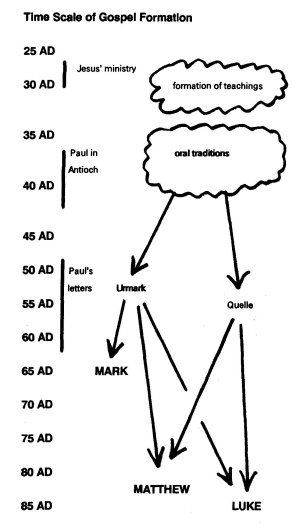
It is clear that some traditions must have arisen after
Jesus' death and resurrection. The passion narrative belongs to this category.
The passion stories in all four Gospels are remarkably similar, as anyone will
have noticed from the readings during Holy Week, In fact, if one matches Mark
14,1 -16,8 with Matthew 26,1 - 28,8 and Luke 22,1 - 24,11, one will find that
the three evangelists recount 25 episodes in more or less the same sequence and
with more or less the same formulations. We may surmise the existence of an
oral account of Jesus' passion that preceded the three Gospels (21).
Other traditions go back to the time of Jesus' ministry
itself.(22) Jesus gathered disciples around him, as Jewish teachers did.(23) He
gave them special instructions. On certain occasions he sent them out to preach
his message to villages and towns in Galilee and Samaria. Since the disciples
were Jesus' messengers who spoke on his behalf, they took the contents of their
preaching from what Jesus had said and done. They would repeat Jesus' call to
repentance. They would reiterate his challenging images and parables. They
would narrate Jesus' prophetic miracles and would impose healing hands in his
name. They would defend him from criticism by repeating his indictments of
pharisaic legalism.
That is how the earliest oral tradition arose. It was a collection
of Aramaic, memorised texts in which Jesus' teaching was remembered and passed
on. The existence of this oldest, Aramaic, layer has already been demonstrated
in the previous chapter when we discussed the 'measure' and 'salt' passages.
What I did not point out at the time was the fact that the peculiar mix of
differences and samenesses in many synoptic passages cannot be solely due to
the pen of the evangelists but requires an underlying oral tradition.
Compare, for instance, this
simple question in Matthew, Mark and Luke. Notice not only the small variations
in wording (obtain / inherit; what should I do / having done what), but
especially how the word 'good' has travelled (good master what / master what
good). In Greek there can be no mistaking: 'good' in the address is kale
(Matthew, Luke) but as object kalon (Mark); and also its location in the
sentence is different.
| Matthew 19,16 |
Mark 10,17 |
Luke 18,18 |
Master,
what good should I do to obtain eternal life?
|
Good master,
what should I do to inherit eternal life?
|
Good master,
having done what will I inherit eternal
life? |
But in the underlying Aramaic, confusion was well possible, for
the word 'good' (tôb) has the same form and could have stood in
the middle:
| rabbi tôb mâ - |
master, what good....? |
| rabbi tôb, mâ - |
master good what....? |
Like this, words often 'slide' to new locations, showing the hand
of an oral tradition. Words are fixed in written texts, not when they have been
learnt by heart. 'What I say in the dark, say in plain daylight' (24)
becomes 'what you say in the dark, will be heard in plain daylight'.(25)
This is the kind of thing that happens when people recall texts from memory.
Another sure sign of oral transmission is the modelling of a text
in a pattern that can easily be remembered. If we reconstruct the oral
tradition that underlies Mark 7,1-13 and Matthew 15,1-9, we discover a powerful
text.(26) The occasion apparently was a visit to Jesus by scribes from
Jerusalem. They objected to the fact that Jesus' disciples 'had not washed
their hands before eating'. What was at stake was not a hygienic matter. The
Jews observed hundreds of little rules concerning the ritual washing of hands
and utensils.
Handwashing Conflict
The Problem
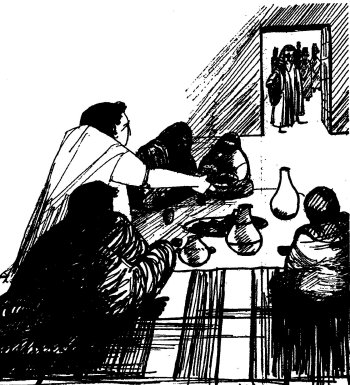 |
| ‘Why do your diciples eat with unwashed
hands?’ they said (Mark 7,5) |
Then came to Jesus from Jerusalem the Pharisees and scribes
saying:
"WHY do your disciples TRANSGRESS the TRADITION of the elders?
For they do not wash their hands when they eat!"
Jesus' reply
Jesus replied:
"WHY do you TRANSGRESS the COMMANDMENT of God?
For you make
void God's word for TRADITIONS of men!"
First Recital (Exodus text)
And he said to them:
"RIGHTLY - is it? - you put aside the precept of God in order to
keep your traditions?
For Moses commanded: 'HONOUR your father and mother'
and 'He who speaks evil of father or mother, dying let him die,(27) but you
say: 'If a man tells his father or mother "what you would have gained from me
is korban", he need not honour his father or mother'.(28)
Refrain
Thus you make void the word of God
for the traditions
you hand on.
And many similar things you
do.
Second Recital (Isaiah text)
And he said to them:
"RIGHTLY did Isaiah prophesy of you, hypocrites, as it is
written: 'This people HONOUR me with their lips, but their heart is far from
me. In vain do they worship me, teaching as teachings the commandments of
men!'(29)
For you wash the cups on the outside, but the insides are full
with the fruits of your extortion and greed.(30)
Refrain
Thus you make void the word of God
for the traditions
you hand on.
And many similar things you do.
Notice the use of key words: WHY - TRANSGRESS -TRADITION (which
identify the whole unit) and the two words RIGHTLY and HONOUR (31) that link
the two recitals. The structure is also simple: the opening question raises the
issue; Jesus' reply is first summed up in a terse statement, then repeated in
the refrain; the recitals provide two proofs. In this form even a complicated
argument could be easily and accurately retained. But when remembering the
text, people would obviously 'hang' them on the key words and refrains; that is
why the order could be easily switched. The key word HONOUR would remind people
of both the texts in Exodus and in Isaiah but not of their sequence. Some
people might, therefore, switch the order of the recitals; and this is exactly
what happened. In fact, we do not know for sure which was first, which second.
| Matthew 15,1-9 |
Mark 7.1-12 |
Exodus recital
Isaiah recital |
Isaiah recital
Exodus recital |
The tradition as we have it now, has been cast into a highly
stylised mould. The debate which it summarises was probably a much more chaotic
affair, with questions and accusations, arguments and counter-arguments. Who
formulated the text in its present shape, with summaries, recitals and
refrains?
Many scholars would ascribe its formulation to a catechist in the
Early Church. They would defend a later date of origin responding to a life
situation (32) of conflict between orthodox Jews and their Christian
neighbours. This is, indeed, possible. Even then the originally Aramaic form
postulates a time of origin in Palestine not long after the Easter event.
It is equally possible, however, that the formulation goes back to
Jesus himself. Already during Jesus' ministry a similar life situation existed.
Jesus sent his disciples out to preach and they must have felt the urgent need
to defend themselves against rabbinical opposition. (33) Let us not forget that
it was this conflict that would ultimately lead to Jesus' death. It is not
unthinkable that after a debate, or a number of debates, Jesus would formulate
a succinct answer and make his disciples learn the text by heart. This is
precisely what Rabbis used to do whenever they had had important debates with
their opponents. The memorised tradition itself would then owe its formulation
to Jesus. (34)
How not to forget
People who have to learn texts by heart know this can be done more
easily if there are little 'helps' in the text. These are called
mnemonic devices.(36)
'Catch words' are one of them. They frequently serve to string
shorter passages together in an oral chain. Mark 9,37-50 provides an example.
| 9,37 |
receives a little one in my name |
| 9,38-40 |
casting out devils in my name |
| 9.41 |
name of Christ |
| 9.42 |
if you cause a little one to
stumble |
| 9.43 |
if your hand causes to stumble |
| 9;44 |
if your foot causes to stumble |
| 9.47 |
if your eye causes to stumble |
| 9.48 |
where there is fire |
| 9.49 |
salted with fire |
| 9,50 |
salt is good but.... |
We can see how the passages were linked together by the
catchwords: little one - name - stumble - fire - salt. There are also hidden
connections that we may have lost. For example, verses 42-47 speak of
amputations ('cut off your hand, etc.'); fire and salt were used to cauterise
the wound.(37) Examples like this can be multiplied.(38)
Before the four Gospels of Matthew, Mark, Luke and John were
written down, much of the material recorded in them existed as oral literature.
This is not to be confused with rumour, hearsay or even 'oral history', i.e.
the way individuals may remember and recount events or people they have known.
Oral literature is literature because it is transmitted in well-defined forms,
such as epics, ballads, legends, or, as in the Gospels, the words and deeds of
a great master.(39) Oral literature is more flexible than written literature.
It allows for elaboration and expansion of individual episodes and of
sequences. The sequences are frequently switched round (AB in one and BA in
another).(40) The same episode is often repeated in slightly different
forms.(41) The Gospels, therefore, still bear the traces of the oral
traditional literature on which they were based.(42)
This then was the tradition which Paul and other teachers handed
on to the Christians at Antioch. It was, we can be sure, not just a question of
sermons and pious reflections which would occasionally refer back to what Jesus
had said and done. It was a matter of real instruction, of transmitting and
explaining the various sections of the Jesus tradition:
who Jesus was;
his preaching of the Kingdom of God;
the events that led up to his passion and death;
sayings of Jesus
related to everyday life;
how Jesus as the Risen Lord was now present in
their assemblies and in all they did.
This was the oldest Gospel as it lived in people's memories and
hearts.
And what about us?
Jesus said: 'If my word remains in you, you will truly be my
disciples'.(43) The early Christians took this seriously. They learnt large
sections of Jesus' words by heart. What is our responsibility in this regard?
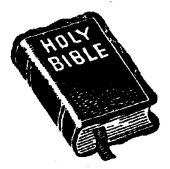 |
Do you have a copy of Sacred
Scripture at home? |
Do you regularly read it, on
your own or with others? |
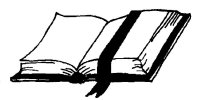 |
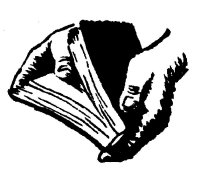 |
Do you talk and pray with
others about its meanin for your life? |
Nowadays it is not difficult to come by a printed copy of Sacred
Scripture. We can either obtain the whole Bible, a copy of the New Testament or
separately printed copies of the Gospels. A selection of versions is available
ranging from rather literal translations (e.g. the Revised Standard Version) to
more up-to-date, readable renderings (e.g. the Good News Bible). Some versions
provide helpful introductions and footnotes (notably the Jerusalem Bible).
However, has this plethora of printed editions really benefited us?
Possessing the text in print may make us believe that it has
become part of us; but could we be fooling ourselves? Studies have shown that
many homes have a copy of Scripture without it ever being consulted. The truth
is: the inspired word is only part of us to the extent that we have
internalised it; that is, to the extent it has become part of our mental
resources and inner vision of life.
Would it be such a bad idea to commit to memory striking phrases
of the Gospel? We know from psychology that we all carry in our mind 'parental
injunctions': phrases we copied from our parents and teachers that enshrine
principles and values. By repeating these principles internally, we make them
the unconscious carriers of our day-to-day decisions. Why not give such a
central role to Jesus' sayings?
* 'If you're not faithful in handling worldly wealth, how can
you be trusted with true (spiritual) wealth?(44)
* 'If you salute only your friends, have you done anything
special?(45)
* 'As for you, even the hairs on your head have all been
counted. You are worth much more than many sparrows'.(46)
* 'With my own eyes I have seen your salvation which you have
prepared for all nations*.
* 'Don't be afraid. It is me!'(47)
It is not difficult to gradually build up our inner store of such
Gospel values. All we need to do is retain a beautiful phrase when we meet it;
then repeat it often in the course of the day. We should also promote the
'treasury approach' with regard to the printed copy of the Bible. Instead of
keeping the whole book as an amorphous mass of text, we could mark in it
passages that touch us in a special way. These texts we could meditate on with
preference and read more often. Sacred Scripture then becomes a more personal
book.
QUESTIONS FOR STUDY
1. In which things do you rely on memory, in which on writing?
Are there passages of the Gospel that you know by heart?
2. Consider these passages from Matthew 6,1-6.16-18:
Do not practice your piety before people, hoping that they will
see you. For then you will have no reward from your heavenly Father.
So when you give alms, do not blow the trumpet, as the
hypocrites do in the synagogues and in the streets to receive people's praise.
I tell you, they got their reward. Rather, when you give alms, do not let your
left hand know what your right hand is doing so that your aims are given in
secret. And your Father, who sees what you do in secret, will reward you.
And when you pray, do not do like the hypocrites; for they love
to pray standing op in the synagogues and the streets to be seen by people. I
tell you, they got their reward. Rather, when you pray, go inside and shut the
door and pray to your Father in secret. And your Father who sees what you do in
secret, will reward you.
And when you fast, do not look gloomy, like the hypocrites. They
put on a dismal expression so that their fasting is seen by people. I tell you,
they got their reward. Rather, when you fast, put oil on your head and wash
your face so that your fasting is not seen by people but by your Father. And
your Father who sees what you do in secret, will reward you.
a. What traces of memorisation do you discover in this text?
b. What, do you imagine, was the occasion of Jesus formulating the
text?
c. What happened to the text in Matthew's Gospel (see 6,1-18)?
Footnotes
1. Acts 11,26. The early Christians recognised 'teachers' as
members of the community with a special function; 1 Corinthians 12,28;
Galatians 6,6. The anti-Christian Hellenist historian Malalas, who lived in
Antioch two centuries later, records the tradition that Paul and Barnabas
taught in a house in an alley called Siagon ('jawbone'); MALALAS
242.11-12; ed. A.SCHENK VON STAUFFENBERG, Die römische Kaisergeschichte
bei Malalas, Stuttgart 1931, in loco.
2. F.D.GRAVES, A History of Education before the Middle
Ages, New York 1909; J.F.DOBSON, Ancient Education and its Meaning to
us, New York 1932; E.B.CASTLE, Ancient Education and Today,
Harmondsworth 1961; H.MARROU, Histoire de l'éducation dans
l'antiquité, Paris 1965.
3. Acts 13,1
4. He cites three well-known proverbial phrases (Acts 17,23; 1
Corinthians 15,33; Titus 1,12), but he never quotes classical Greek drama or
poetry as literary students or rhetorically trained speakers did.
5. 'I, Tertius, the writer of this letter greet you'; Romans
16,22.
6. 1 Corinthians 16,21 -24; Colossians 4,18; 2 Thessalonians
3,17-18.
7. 'See with what large letters I am writing to you with my own
hand'; Galatians 6,11.
8. Acts 22,3.
9. BICKERMANN, 'La Chaine de la tradition Pharisienne',
Révue Biblique 59 (1952) pp. 44-54
10. The traditions of the elders laid down the observance and
practice of Mosaic Law. The mishnah was the collection of these oral
traditions (from 200 EC to 400 AD).
11. I have extracted these from B.GERHARDSSON, Memory and
Manuscript. Oral Tradition and Written Transmission in Rabbinic Judaism and
Early Christianity, Uppsala 1961, esp. pp. 122-144.
| 12. 2 Thessalonians 3,6. |
13. 1 Corinthians 11,2. |
14. 2 Thessalonians 2,15. |
15. 1 Corinthians 4,16-17. |
16. Romans 6,17. |
17. 'I handed on to you what I have also received ....'; 1
Corinthians 15,1-11.
18. 'I received from the Lord what I in turn handed on to you'; 1
Corinthians 11,23-26.
19. 1 Corinthians 7,10. B.GERHARDSSON shows well how Paul in the
whole of chapter 7 presupposes knowledge of and respect for Jesus' teaching;
The Origins of the Gospel Traditions, London 1979, esp. pp. 33-41.
20. Compare 1 Corinthians 9,14 and Luke 10,7; Galatians 6,2-3 and
Mark 9,33; 2 Corinthians 10,1 and Matthew 11,29; Romans 12,14-17 and Matthew
5,38-44; Galatians 5,14 and Luke 10,25-28; see also D.L.DUNCAN, The Sayings
of Jesus in the Churches of Paul, Philadelphia 1971; F.NEYRINCK, 'Paul and
the sayings of Jesus', in L'Apôtre Paul, ed. A.VANHOYE, Louvain
1986, pp. 265-321.
21. Even Mark; J.FINNEGAN, Die Überlieferung der
Leidens-und Auferstehungsgeschichte Jesu, Giessen 1934.
22. For a reconstruction of the pre-Easter settings of Gospel
formation and the contents of the earliest preaching, see H.RIESENFELD, 'The
Gospel Tradition and its Beginnings', Texte und Untersuchungen zur
Geschichte der altchristlichen Literatur 73 (1959) pp. 43-65; H.SCHURMANN,
'Die vorosterlichen Anfänge der Logientradition in Der historische
Jesus und der kerygmatische Christus, ed. H.RISTOW and K.MATTHIAE, Berlin
1960, pp.342-370; G.DELLING, 'Gepragte Jesus-Tradition im Urchristentum'
Communio Viatorum 1 (1961) pp.61-71; P.E.DAVIES, 'Experience and
Memory', Interpretation 16 (1962) 181-192; X.LEON-DUFOUR, Les
Évangiles et I'Histoire de Jésus, Paris 1963, pp. 301-314.
23. In the Gospels Jesus is called a 'teacher'45 times, 'Rabbi' 14
times. Although Jesus did not undergo the normal training of a Rabbi, his
actions resembled one in many ways. J.JEREMIAS, Jerusalem in the Time of
Jesus, New Haven 1969, pp.233-245.
24. Matthew 10,27.
25. Luke 12,3. More examples can be found in A.ROBERT and
A.FEUILLET, Introduction à la Bible, Paris 1959, pp. 269-271.
26. This is my own reconstruction; but see L.de GRANDMAISON,
Jésus Christ, Paris 1931, vol. I, introduction; J.HORST,
‘Die Worte Jesu über die kultische Reinheit und ihre Verarbeitung in
den evangelischen Berichten’, Theologische Studien Kreise 87 (1914)
pp.429-454.
27. Exodus 20,12; 21,17; Leviticus 20,9; Deuteronomy 5,16.
28. This was a 'legal escape', an ‘erub’. Suppose
a man's father was in financial need. To escape having to support him the son
might make a conditional vow, stating: 'What you could gain from me, I would
make an offering (korbân) to the Temple'. This absolved the son
from all obligations. He could no longer give help to his father (for the vow
would oblige him to change it into an offering). Nor did he need to make an
actual offering, because the vow was only conditional!
29. Isaiah 29,13.
30. See also Matthew 23,25; Luke 11,39-41.
31. In Aramaic these correspond to the construction with
hêbî and the root of kabad.
32. The technical term for such life situations in which texts
were formulated is the German word Sitz-im-Leben.
33. See Luke 9,1-6; 10,1-20; Matthew 9,35 -10,16. H.SCHURMANN, 'Mt
10,5b-6 und die Vorgeschichte des synoptischen Aussendungsberichtes', in
Neutestamentliche Aufsätze, Regensburg 1963, pp.270-282.
34. W.GRUNDMANN (in Die Geschichte Jesu Christi, Berlin
1957, p.21) highlights the likelihood of Jesus making his disciples learn key
texts by heart. There is absolutely no ground for reducing memorised traditions
to short 'gnomic sayings' as I.HENDERSON would have it; see 'Sententiae
Jesu': Gnomic Sayings in the tradition of Jesus, Oxford 1988. 'Jesus
recruited and trained apostles and sent them out to be fishers of men. Part of
the training they received was memorising a collection of stock parables and
other teachings necessary to the answer the questions put to them';
G.W.BUCHANAN, 'Chreias in the New Testament, in Logia. The Sayings of
Jesus, ed.J.DELO-BEL, Louvain 1982, pp. 501-505.
35. From the Greek mnêmoneuein, 'to remember'.
36. J.D.M.DERRETT, 'Salted with Fire. Studies in texts: Mark
9,42-50', Theology 76 (1973) pp. 364-368.
37. E.SCHWEIZER, Das Evangelium nach Markus, Gottingen
1967, p. 111; H.W,KUHN, Ältere Sammlungen im Markusevangelium,
Göttingen 1971; J.M.ROBINSON, 'Early Collections of Jesus' Sayings' in
Logia, ed J.DELOBEL, Louvain 1982, pp. 389-394
38. About oral literature, read A.B.LORD, The Singer of
Tales, Harvard 1960; further literature in E.R.HAYNES, Bibliography of
Studies Relating to Parry's and Lord's Oral Theory, Harvard 1973.
39. See, for example, the switch of the two recitals in Matthew
15,1-9 and Mark 7,1-13; in the temptation story DESERT -PINNACLE OF THE TEMPLE
- MOUNTAIN in Matthew 4,1-11 and DESERT - MOUNTAIN - PINNACLE in Luke 4,1-13.
40. For example, the healing of the blind man near Jericho
(Matthew 20,29-34; Mark 10,46-52; Luke 18,35-43; notice the variations!) gave
rise to a derived version (Matthew 9,27-31). The multiplication of the loaves
was recounted in two versions (Matthew 14,13-21; Mark 6,31-44; Luke 9,11-17 and
Matthew 15,32-39; Mark 8,1-10).
41. A.B.LORD, 'The Gospels and Oral Traditional Literature' in
The Relationship among the Gospels, ed. W.O.WALKER, San Antonio, pp.
33-91; see also E.L.ABEL, 'The Psychology of Memory and Rumor Transmission and
Their Bearing on Theories of Oral Transmission in Early Christianity, The
Journal of Religion 51 (1971) pp. 270-281.
| 42. John 8,31. |
43. Luke 16,11. |
44. Matthew 5,47. |
45. Matthew 10,30. |
46. Luke 2.30-31. |
47. John 6,20.
|
